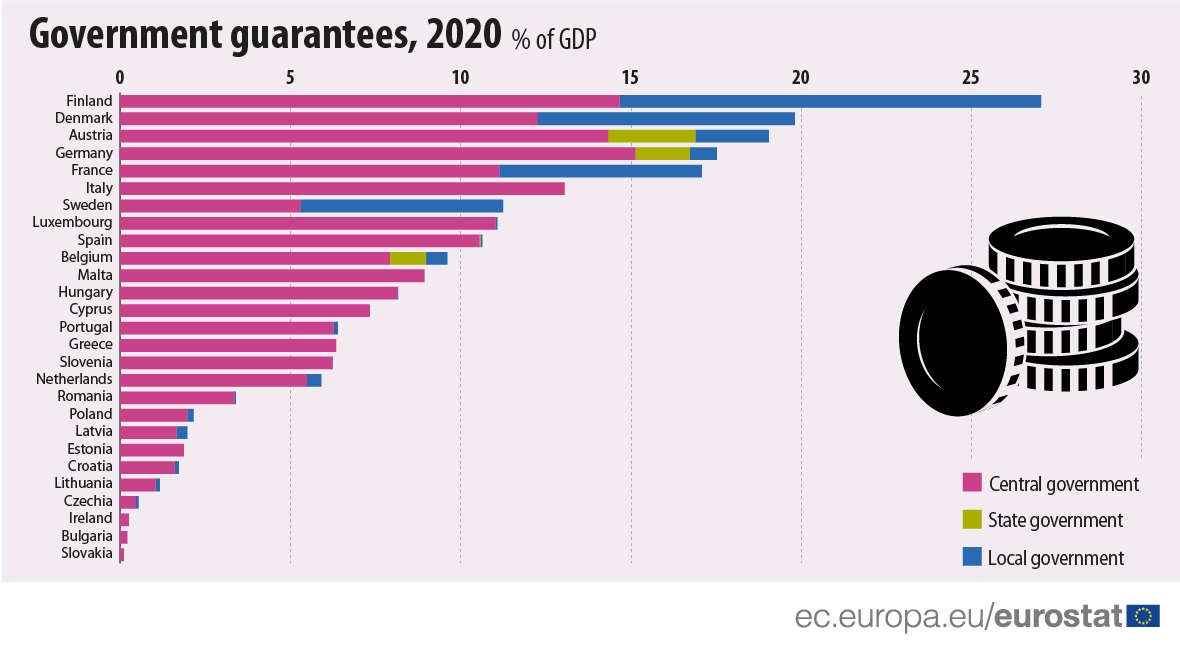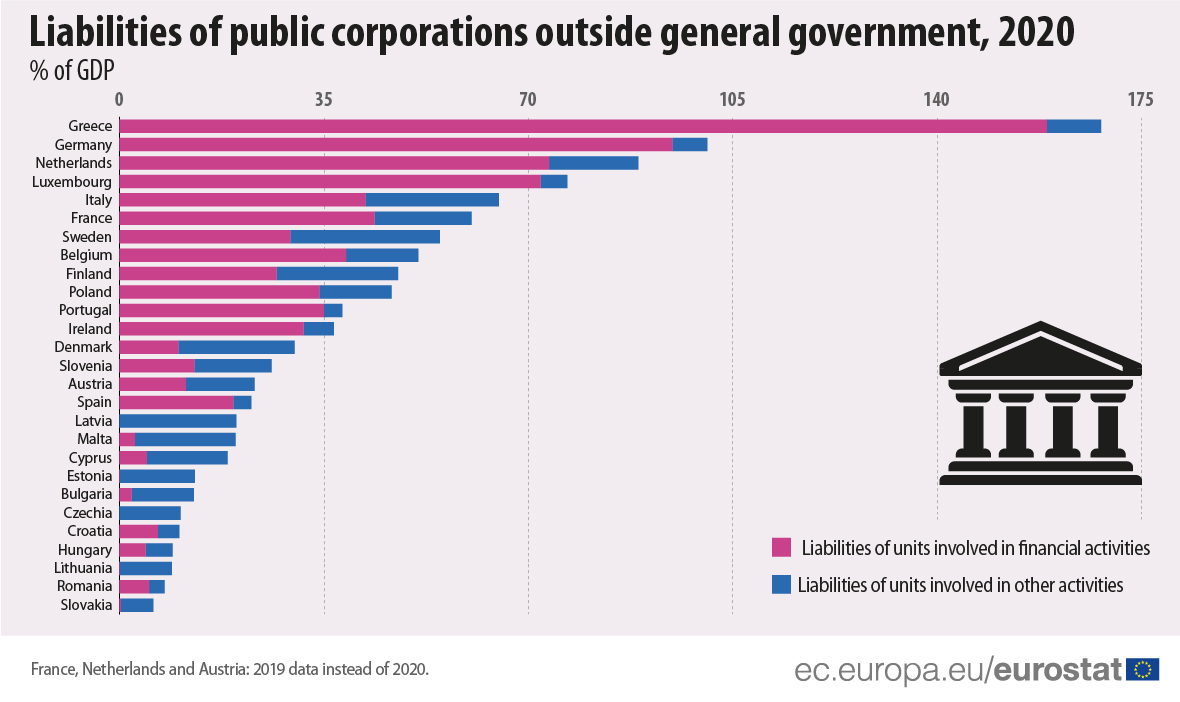In 2020, the highest rates of government guarantees in the EU were recorded in Finland
The most common form of contingent liabilities in the EU Member States is government guarantees on liabilities, and occasionally, on assets of third parties. In 2020, there has been a notable increase of guarantees provided in the EU, due to new government guarantee programmes in the context of the COVID-19 pandemic.
The highest overall rate of government guarantees was recorded in Finland (27.1% of GDP), ahead of Denmark (19.8%), Austria (19.1%), Germany (17.5%) and France (17.1%). Data in Finland also include some guarantees underwritten by a financial public corporation classified outside of government, but only to the extent they are counter-guaranteed by the government. Slovakia was the country with the lowest level of government guarantees (0.1%). Rates of less than 1% of GDP were also recorded in Bulgaria, Ireland and Czechia.
This information comes from data on contingent liabilities and non-performing loans published by Eurostat today. The article presents a handful of findings from the more detailed Statistics Explained article.
In most EU Member States, the central government is the predominant guarantor. A notable level of state and/or local government guarantees can also be seen in Finland, Denmark, France, Sweden, Austria, Germany and Belgium. In several countries - Belgium, Spain, France, Cyprus, Luxembourg, Portugal and Finland - a major part of the guarantees are provided to financial institutions, often granted in the context of either the COVID-19 crisis, or the 2008-09 financial crisis.
Source dataset: gov_cl_guar
Liabilities of public corporations the highest in Greece
The level of liabilities of public corporations classified outside general government in 2020 varied widely across the EU Member States. Significant amounts of liabilities were recorded in Greece (170.6% of GDP), ahead of Germany (100.7%), the Netherlands (88.9%) Luxembourg (76.7%) and Italy (65%).
In contrast, small amounts of public corporation liabilities were recorded in Slovakia (5.8%) followed by Romania (7.7%), Lithuania (9%), Hungary (9.1%) and Croatia (10.3%).
The main reason for the high level of these liabilities in certain Member States is that the data include government controlled financial institutions, in particular public banks. Most of these liabilities consist of deposits held in the public banks by households or by other kinds of private or public entities. In general, financial institutions report high amounts of debt liabilities and have, at the same time, a significant level of assets, which are not captured in this data collection.
Source dataset: gov_cl_liab
Slovakia and Portugal with largest liabilities related to off-balance PPPs
In all EU Member States, liabilities related to off-balance public-private partnerships (PPPs, long-term construction contracts where assets are recorded outside government accounts) were below 2.5% of GDP in 2020. Slovakia had the highest share (2.4% of GDP), followed by Portugal (2.3%) and Hungary (1.1%). In both Slovakia and Portugal, the liabilities relate mainly to motorway projects.
In many EU Member States, off-balance PPPs were observed at the level of central government, whereas in Spain, Belgium and Austria they were also notably related to state and local governments.
Cyprus remained the country with the highest level of non-performing loans
In 2020, Cyprus remained the country with the highest stock of non-performing loans (assets) of general government, at 28.3% of GDP, a far larger share compared with other EU Member States. This was due to a large transaction in 2018, whereby non-performing loans from a Cypriot public financial corporation (classified outside government) were transferred to a government unit.
Three other EU Member States recorded a share higher than 1% of GDP: Slovenia (2.2%), Portugal (1.5%) and Croatia (1.4%). For Cyprus, Slovenia and Portugal, the majority of non-performing loans refer to loans of financial defeasance structures. In the case of Croatia, the figure mainly refers to the loans of a national development bank (classified inside general government).
For more information
- France, Netherlands and Austria: 2019 instead of 2020 data on liabilities of public corporations.
- Eurostat Statistics Explained article on Contingent liabilities and non-performing loans
- This article includes data on:
- contingent liabilities (potential liabilities) which may become actual government liabilities if some specific conditions prevail;
- government guarantees;
- liabilities related to public-private partnerships (PPPs) recorded off-government-balance-sheet;
- liabilities of government-controlled entities (public corporations) classified outside general government;
- government non-performing loans (NPLs, assets), which could imply a loss for government if these loans are not repaid.
- Data on guarantees do not include:
- government guarantees issued within the guarantee mechanism under the Framework Agreement of the European Financial Stability Facility (EFSF) and the European Stability Mechanism (ESM);
- derivative-type guarantees meeting the ESA2010 definition of a financial derivative;
- deposit insurance guarantees and comparable schemes;
- government guarantees issued on events which occurrence is very difficult to cover via commercial insurance (earthquakes, large scale flooding, etc.).
- Off-balance sheet PPPs data do not include the liabilities related to off-balance sheet concession contracts, as per the concession definition in Chapter 2 of the Guide to the Statistical Treatment of PPPs.
- The data in this article refer to 31 December 2020 (with a few minor exceptions for liabilities of government-controlled entities classified outside general government). According to the Decision of Eurostat from 2013, contingent liability data are reported by the EU Member States annually each December, with a typical time lag of T+12 months. The current article therefore occurs with a time lag of T+13 months.
- Data on contingent liabilities and potential obligations of government are provided by the EU Member States in the context of the Enhanced Economic Governance package (the "six-pack") adopted in 2011. In particular, Council Directive 2011/85 on requirements for budgetary frameworks of the Member States requires the Member States to publish relevant information on contingent liabilities with potentially large impacts on public budgets, including government guarantees, non-performing loans, and liabilities stemming from the operation of public corporations, including the extent thereof.
- Contingent liabilities are not part of the general government (Maastricht) debt, as defined in the Council Regulation (EC) No 479/2009 of 25 May 2009 on the application of the Protocol on the excessive deficit procedure annexed to the Treaty establishing the European Community.
- Eurostat overview on Government finance statistics
- Eurostat database on Government finance statistics and EDP statistics
To contact us, please visit our User Support page.
For press queries, please contact our Media Support.



